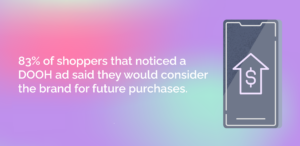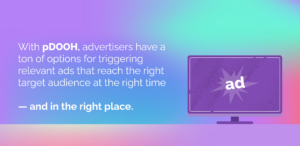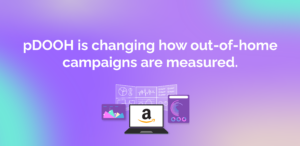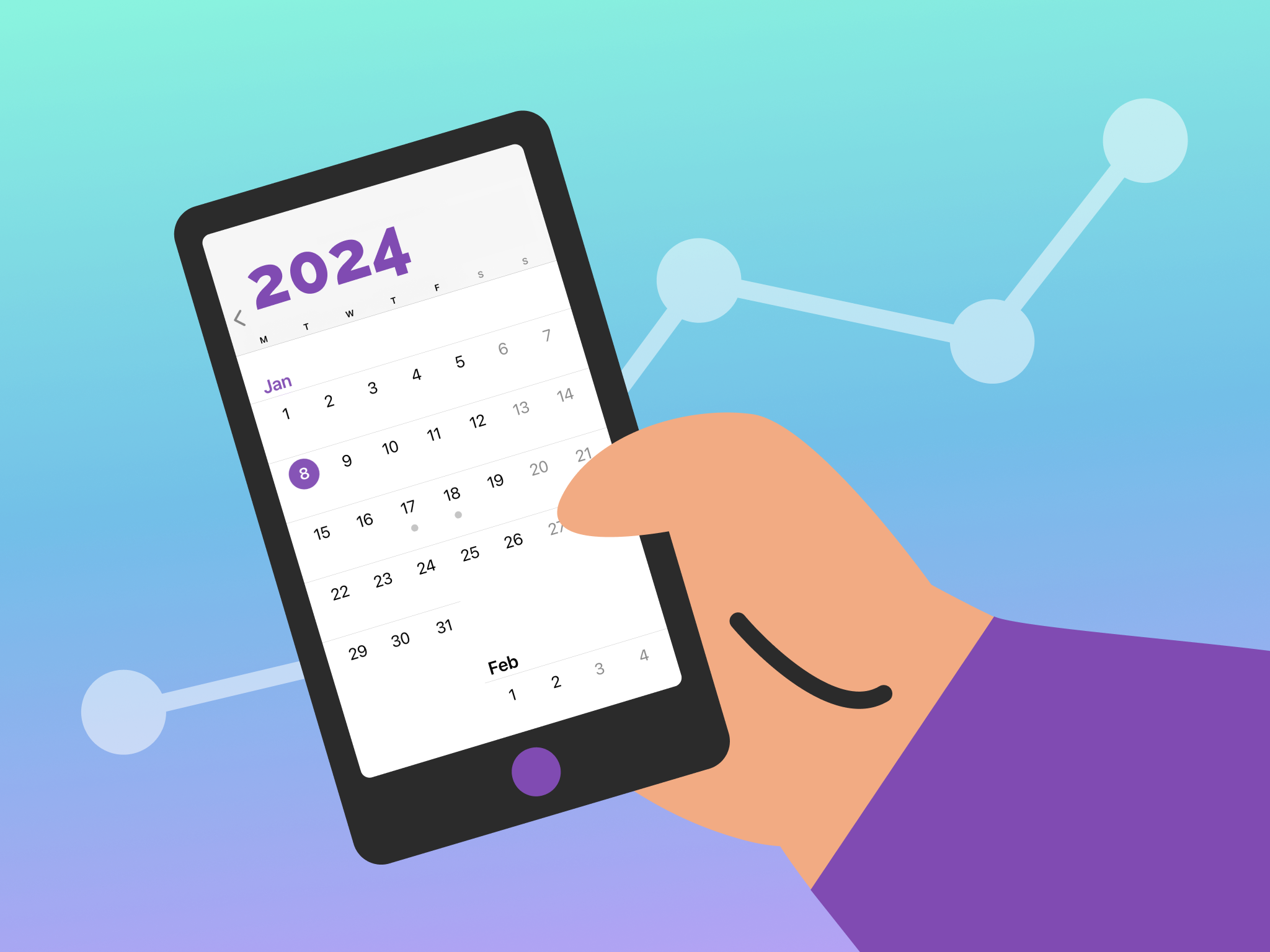The last few years have seen rapid uptake of online programmatic advertising thanks to its laser-precise targeting, automated bidding, and the ability to optimize campaigns in real-time — all of which contribute to more effective ad campaigns that drive more sales and improve return on ad spend (ROAS).
Until recently, programmatic adtech options were only available for online ads, but they’re now moving into the real world with the introduction of programmatic digital out-of-home advertising (pDOOH).
pDOOH brings many of the benefits of programmatic advertising abilities to the offline world. So it’s hardly surprising that pDOOH is taking up an ever-increasing share of digital out-of-home spend and projected to grow at a rate of 41.59% CAGR between 2021 and 2027.
According to research by Yahoo!, pDOOH ads can nudge customers toward impulse buys — 55% report having purchased an item after seeing it on a digital billboard. Meanwhile, 83% of shoppers that noticed a DOOH ad said they would consider the brand for future purchases.

As digital signage and billboards become increasingly prevalent, savvy advertisers are harnessing the power of programmatic technology to bring their messages to customers wherever they are.
This article will cover the main benefits of pDOOH (and its advantages over traditional DOOH advertising). But first, let’s revisit what pDOOH is and how it works.
First, A Recap of What Programmatic DOOH Is
pDOOH leverages the same technology as online programmatic advertising to automate the buying and selling of ad inventory on digital screens.
Rather than showing generic ads to all passers-by, pDOOH placements are dynamic and serve ads that are relevant to the people in the vicinity.
Using algorithms and automated bidding, pDOOH advertisers can reach highly-targeted audiences while they’re on the go through digital displays.
In other words, programmatic DOOH enables digital media buyers to:
- Identify audiences they want to reach in relevant ad environments.
- Target customers based on information such as demographics, behavior, and location data.
- Deliver contextually-relevant ads based on the time of day, location, weather conditions, and news stories.
- Optimize campaigns in real-time for maximum impact.
- Measure the success of their DOOH campaigns.
Using ad exchanges and demand-side platforms (DSPs), advertisers can automatically bid on ad inventory. When the circumstances are right and the conditions are met, the transaction automatically takes place, and the ad displays on screen — all within a matter of seconds.
Now let’s look at some of the main benefits of pDOOH.
The Benefits of pDOOH
Is pDOOH the right option for you? Take a look at the following benefits to help you decide.
Improved, Data-Driven Targeting
pDOOH offers all the benefits of traditional DOOH — and much more. Whereas DOOH is the real-world advertising equivalent of “spray and pray,” pDOOH harnesses multiple customer data sources to deliver highly targeted out-of-home ad campaigns.
With pDOOH, advertisers have a ton of options for leveraging multiple data sources and triggering relevant ads that reach the right target audience at the right time — and in the right place.

Here are just a few examples of ways you can use data to deliver targeted pDOOH campaigns:
- You can serve an ad based on the time of day or other advanced options, like the weather, daily market performance, ongoing results of a sporting event, or custom audience data, such as household income.
- pDOOH enables you to use historic audience location data to trigger content and deliver contextual messages that are relevant to audiences in a specific location.
- pDOOH also allows you to use multiple triggers based on a variety of data sources for more granular targeting.
- You can collect data from mobile device IDs in a process known as mobile tagging. This helps you understand where consumers go, how they spend their time, and which buying paths they take.
Better Campaign Measurement
With traditional DOOH, the options for tracking the success of a particular campaign are limited, as it’s almost impossible to know who has viewed your ads. Additionally, campaign data is often hard to come by and is not available in real-time.
pDOOH is changing how out-of-home campaigns are measured. It enables you to track campaign effectiveness in real-time and measure ad impressions through mobile tagging and third-party data providers.

Having access to this data in real-time makes it easier to plan and optimize ad campaigns to improve ROAS. For example, with pDOOH, you can measure metrics such as:
- Intent and consideration (via device graph partners)
- Number of impressions served
- Real-time in-flight campaign pacing
- Brand awareness or recall (via third-party surveys and partners)
- In-store visits (foot traffic)
The data pDOOH provides can even contribute to attribution, which can help you understand the role your pDOOH ads play within the context of your overarching campaign strategy.
Increased Engagement and Better Connections
Some pDOOH placements have integrated movement sensors that can detect dwell time and ad engagement. This can improve the effectiveness of your ads to increase engagement and enables retargeting of users who engage with your ad across other channels.
Additionally, factors such as audience-specific targeting and geo-fencing ensure the right people will see your campaigns at the right time. Showing relevant, memorable ads can create a positive user experience that strengthens connections with your target audience and raises brand awareness and trust.
Improved Ad Efficiency
Non-programmatic ad buying involves a significant amount of negotiation, usually with OOH advertising agencies and other third parties.
pDOOH offers automation of the ad buying and selling process using algorithms that take the human element out of the process, meaning your ads can be served in a matter of seconds rather than days or weeks.
This increases campaign efficiency while improving the accuracy of ad targeting. It also means advertisers can spend less time negotiating and more time on the strategic work that really matters.
Better pricing and flexibility
Unlike traditional DOOH buying processes, which mainly involve buying fixed slots on inventory, pDOOH lets you specify key conditions — such as impressions and CPM — that need to be met in order to display your ad.
Your ad creative only goes live when these conditions are met — and you only pay when the ad is served. This flexibility can minimize your campaign costs while helping you reach your target audience at the right time and place.

pDOOH also enables you to optimize ads throughout the campaign, which helps to increase your ROAS.
Automated decision-making
With DOOH, you have to manually select and negotiate inventory rates, whereas with pDOOH, you can choose whether to select manually or let the DSP automatically bid for an impression.
The supply-side platform (SSP) then decides who wins the impression — whether through an open real-time auction or a private marketplace (PMP).
What’s Next? Your First Programmatic DOOH Campaign
Digital out-of-home is the next frontier of programmatic advertising, and pDOOH looks set to take over digital billboards the way programmatic has in online advertising.
Advertisers who start using this technology early are bound to gain an advantage over their competitors because pDOOH is streamlining the entire DOOH buying process, making it digitally scalable as well as more interactive, flexible, and measurable.
That said, adopting pDOOH may be a challenge for advertisers who are unfamiliar with the technology behind it.
That’s why many businesses choose to partner with a pDOOH specialist like Grapeseed Media. Our team of programmatic experts can create, manage, measure, and optimize custom pDOOH campaigns so you can harness the power of pDOOH without the steep learning curve.
If you’re considering investing in pDOOH, check out this blog post to discover why you should partner with Grapeseed on your next pDOOH campaign.






